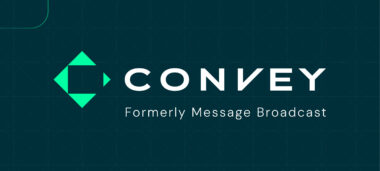
Convey wins platinum MarCom award for brand transformation
We’re thrilled to share that Convey has been recognized with a platinum MarCom award for our 2025 rebrand in the…
Discover how Convey solves problems and fulfills needs.

Message Broadcast rebrands as Convey, marking a
Read More
Message Broadcast rebrands as Convey, marking a
Read MoreWith threats ranging from extreme weather events to cyber-attacks on utilities, emergency preparedness is critical to keeping customers informed and safe. For utilities just starting this journey, focusing on the most critical actions first can make a significant difference.
As part of National Preparedness Month, we have prioritized 30 communications strategies into three categories: Immediate Priorities, Short-Term Actions, and Long-Term Enhancements to guide you through enhancing your emergency preparations program.
Immediate Priorities
The following actions are foundational and should be addressed first to establish a strong emergency preparedness baseline. Implementing these steps can significantly improve your utility’s ability to communicate effectively during crises, while laying the groundwork for a more resilient operation.
Create a detailed crisis communication plan that outlines protocols, key contacts, and messaging strategies for various emergency scenarios. This plan ensures that all communications are coordinated, consistent, and effectively managed during a crisis.
Utilize multiple communication channels—such as SMS, email, chat, social media, web content and mobile apps to disseminate information to customers and stakeholders. Multi-channel systems increase the likelihood that your messages will reach all audiences quickly.
Form a team responsible for managing communications before, during, and after emergencies. This specialized team can focus on crafting messages, monitoring feedback, and coordinating with other departments.
Provide training for all staff on emergency communication procedures and best practices. Well-informed employees can convey accurate information and reinforce consistent messaging across the organization.
Develop a library of pre-approved messages for various types of emergencies. Having templates ready speeds up the communication process and ensures consistency in messaging.
Actively use AI chatbots and social media to share updates, monitor public sentiment, and engage with customers during emergencies. Chat and social media allow for real-time interaction and can help manage misinformation.
Adopt a mass notification system that can send alerts to customers and employees based on their preferences and locations. Advanced systems enhance the speed and accuracy of critical communications.
Offer a mobile app that provides real-time updates, outage maps, and safety information. A well-designed app enhances customer engagement and serves as a reliable information source during crises.
Ensure your website is optimized to handle high traffic and contains dedicated sections for emergency updates. An accessible website is a central hub for information and resources during emergencies.
Short-Term Actions
Once the immediate priorities are underway, focus on the following actions to further strengthen your preparedness in the near term. Implementing these measures will enhance your communication capabilities, ensuring that your utility is even better equipped to handle emergencies effectively as they arise.
Set up efficient internal communication methods, such as intranets or collaboration tools, to keep employees informed. Clear internal communications ensure that staff are aligned and can respond effectively.
Build relationships with local journalists and media organizations for broader dissemination of information. Media coordination helps amplify your messages and reach a wider audience.
Offer emergency communications in the primary languages spoken within your service area. Multilingual options ensure that language barriers do not hinder critical information delivery.
Implement chatbots on your website and apps to handle common inquiries and provide instant responses. AI chatbots can reduce the workload on customer service teams during high-volume periods.
Use geo-targeting to send location-specific alerts and information to affected customers. This approach ensures that communications are relevant and timely for those impacted.
Create strategies for communicating with key stakeholders, including government agencies, suppliers, and community leaders. Proactive engagement builds partnerships that can aid in crisis response.
Coordinate communication plans with local emergency services and first responders. Effective collaboration enhances overall emergency response efforts and public safety.
Long-Term Enhancements
The strategies below focus on sustained improvements and technological advancements to solidify your utility’s emergency readiness over time. By integrating these long-term enhancements, you will ensure your utility remains resilient and adaptable, staying ahead of emerging challenges and continually improving your emergency communication efforts.
Conduct routine tests of all communication channels and systems to ensure they function properly. Regular testing identifies issues before they become critical during an emergency.
Offer interactive maps that display current outages and estimated restoration times. Real-time visuals help customers understand the scope of issues and manage their expectations.
Implement mechanisms for customers to provide feedback on communications and services during emergencies. Feedback helps identify areas for improvement and increases customer satisfaction.
Produce and share content that educates customers on how to prepare for and respond to emergencies. Educational initiatives empower customers and enhance community resilience.
Share video updates from executives to convey empathy and commitment during crises. Personalized messages from leadership can strengthen trust and reassure stakeholders.
Collaborate with neighboring utilities to coordinate messaging and resource sharing. Integrated efforts can provide more comprehensive information and aid mutual assistance.
Use internal alert systems to quickly inform employees of emergency situations and instructions. Prompt employee notifications are essential for safety and effective response.
Regularly update customer and employee contact databases to ensure messages reach their intended recipients. Accurate contact information increases the effectiveness of all communication efforts.
Monitor news outlets and social media to gauge public perception and address misinformation. Awareness of public sentiment allows for timely corrections and adjustments to communication strategies.
Ensure all communications meet accessibility standards for individuals with disabilities. Inclusive communication practices widen your reach and comply with legal requirements.
Set up a physical or virtual center dedicated to managing all communication activities during an emergency. A command center centralizes efforts and improves coordination.
Prepare backup communication methods in case primary systems fail. Contingency planning ensures you can continue communicating despite technological disruptions.
Participate in community events and forums to build relationships and educate the public. Ongoing engagement strengthens community ties and trust in your utility.
Conduct an annual review of all communication plans and practices, updating them based on new technologies and lessons learned. Regular updates keep your strategies effective and aligned with current best practices.
Conclusion
Starting with the most critical actions ensures that your utility builds a solid foundation for emergency preparedness. By systematically addressing these priorities, you can enhance your ability to prevent, respond to, and recover from crises effectively. This commitment not only safeguards infrastructure and maintains essential services but also reinforces customer confidence and community trust.
Ready to take the first step in elevating your utility’s emergency preparedness? Contact our team of experts today for a personalized assessment and a strategic implementation plan tailored to your needs. Together, we can build a more resilient future.
Read other insights and news from the Convey team.

We’re thrilled to share that Convey has been recognized with a platinum MarCom award for our 2025 rebrand in the…

Convey, formerly Message Broadcast, has acquired Powerley. By combining Convey’s expertise in large-scale, compliant communication with Powerley’s advanced energy analytics…

CLIENT: Hawaiian Electric USE CASE: Outage management THE CHALLENGE Hawaiian Electric, serving 95% of Hawaii’s 1.4 million residents, sought to…
Loading...